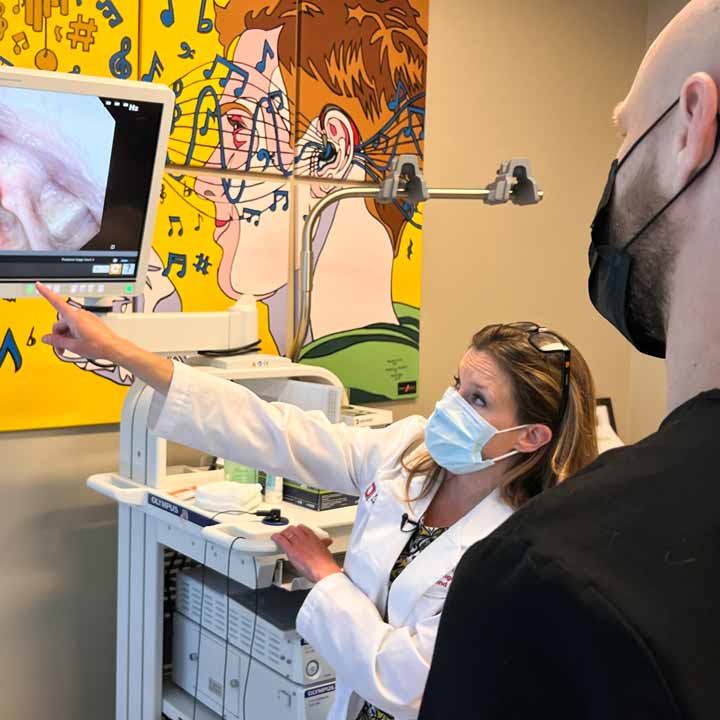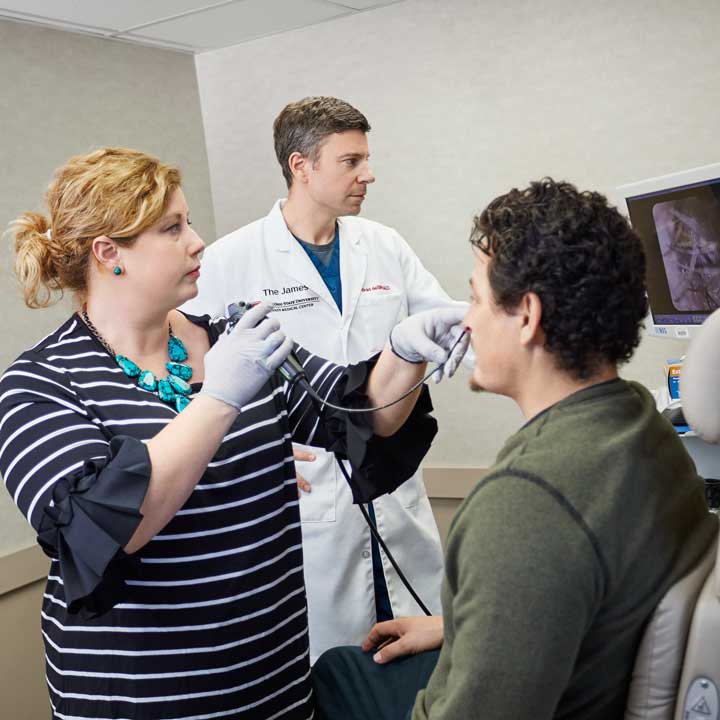 When dealing with vocal issues, such as hoarseness or laryngitis, you’ll want to identify the problem quickly, especially if you’re a teacher, restaurant server or professional singer whose voice is important to your career.
When dealing with vocal issues, such as hoarseness or laryngitis, you’ll want to identify the problem quickly, especially if you’re a teacher, restaurant server or professional singer whose voice is important to your career.
If you have a constant sore throat that won’t go away or other nagging problems, you’ll be anxious to know what’s causing the issue so you can figure out how to fix it.
One of the simplest ways the voice and swallowing specialists at The Ohio State University Wexner Medical Center in Columbus, Ohio, can diagnose voice disorders is with a laryngoscopy. The procedure will guide our decisions about how to treat you, and as one of the largest voice and swallowing centers in the country, we’ll have the resources and expertise to solve any of your health concerns.
What is laryngoscopy?
A laryngoscopy is a procedure that enables a voice and swallowing doctor to examine the larynx (voice box), vocal cords and other structures in the throat.
The larynx houses your vocal cords, which help you speak and sing. It sits between your throat and windpipe.
During this procedure, we’ll put a small flexible tube with a camera on the tip, called a laryngoscope, into your mouth or nose and down your throat to analyze your voice box. Sometimes the instrument can be used to remove a tissue sample for a biopsy, which can be done in an outpatient or office setting.
There are two types of laryngoscopes:
- A direct laryngoscopy – This is when a tube called a laryngoscope is used to look directly at the larynx. The laryngoscope is either flexible or rigid, depending on why the procedure is being done.
- An indirect laryngoscopy – Another form of laryngoscopy doesn’t involve a scope. Instead, a doctor uses a headlight and a tiny, tilted mirror to investigate the back of the throat.
Why do you need a laryngoscopy?
There are a variety of reasons why we might recommend a laryngoscopy. This procedure can serve as not only a diagnostic tool, but it can also be used to acquire a tissue sample for testing as well as treat certain disorders.
Reasons you might need a laryngoscopy include:
- To see the inside of your throat, which is often the first step in figuring out your problem
- To look for inflammation or blockages
- To further examine abnormal spots seen on a CT scan
- To get a biopsy sample of abnormal tissue to see if it’s cancer
- To treat some voice problems, including removing tumors or polyps using incisions or small lasers
- To remove foreign objects
What to expect when having a laryngoscopy
While a laryngoscopy is a common procedure, what you experience during it depends on the reason you need it and what type of laryngoscopy you’re having.
 Before the procedure
Before the procedure
There are no special preparations needed for an office laryngoscopy. You do not have to fast or avoid any of your usual medications.
During the procedure
- Indirect laryngoscopy – Your doctor will simply use a light and a tilted mirror to look into the back of your throat to your vocal cords. This is done in a doctor’s office and without any anesthesia.
- Direct flexible laryngoscopy – You’ll sit in the exam chair and your doctor will insert a flexible, tubular instrument into your nose to get a better look at your larynx and other throat structures. This is done in a doctor’s office and your provider will spray a numbing and decongesting medicine in your nose to make the procedure more comfortable.
- Direct rigid laryngoscopy – This scope is used to get even closer views of your vocal cords. It is a rigid metal tube with a tilted camera in the tip. It is passed just into your mouth to see your vocal cords. Because the camera is tilted, this doesn’t have to pass down far into your throat.
After the procedure
If you had a flexible laryngoscopy, you may feel the numbing effects in your mouth or nose for up to 20 minutes following the procedure. There are no activity or eating restrictions afterwards. If a more involved procedure is performed, like a biopsy or vocal cord injection, you will be asked to avoid drinking or eating for 1-2 hours afterward.
Results of a laryngoscopy
The results of a laryngoscopy are immediate, and our ENT specialists can show you your findings during the same office visit. They are usually able to make treatment recommendations that same day.
However, if we do take a biopsy or culture, you’ll have to wait for those test results. If the biopsy suggests you might have cancer, we can refer you to our laryngeal cancer experts at The Ohio State University Comprehensive Cancer Center – Arthur G. James Cancer Hospital and Richard J. Solove Research Institute (OSUCCC – James) for world-class oncology care.
Additional Information
How would you like to schedule?
Don’t have MyChart? Create an account

